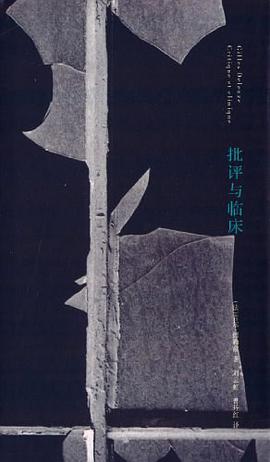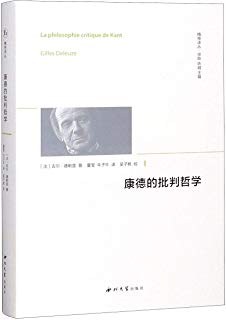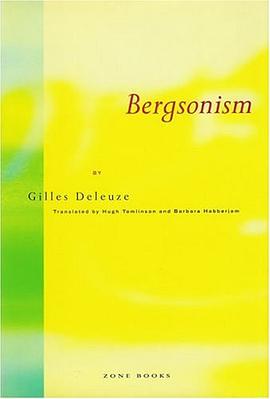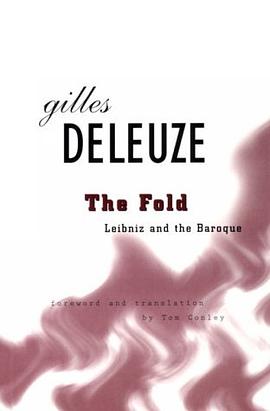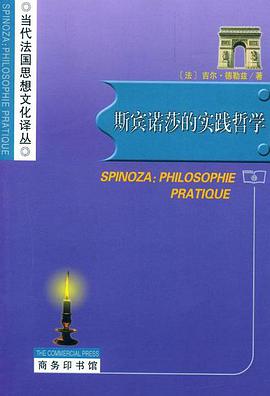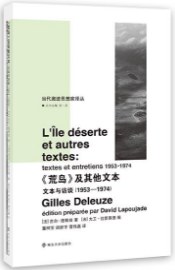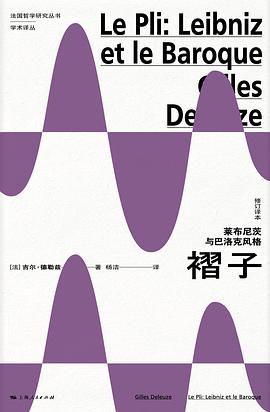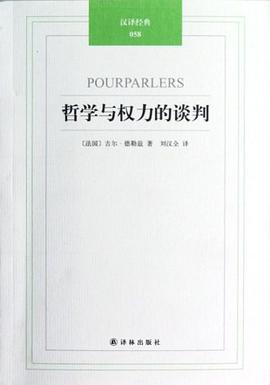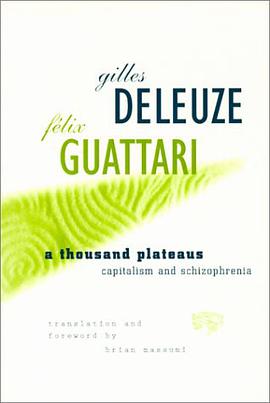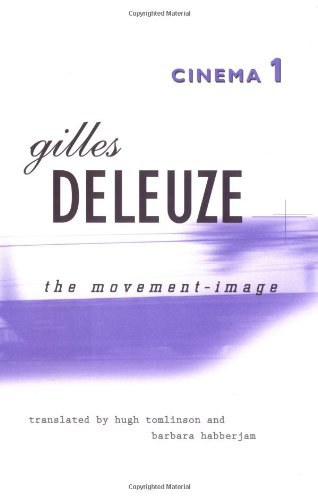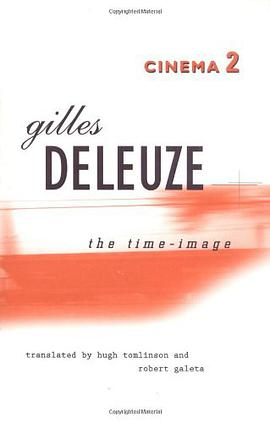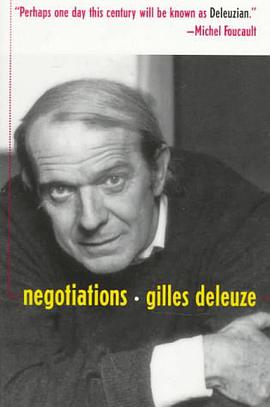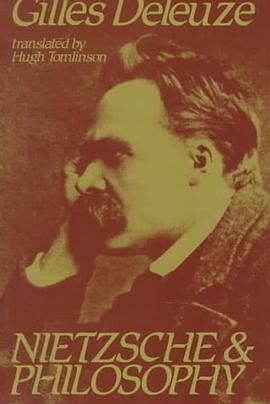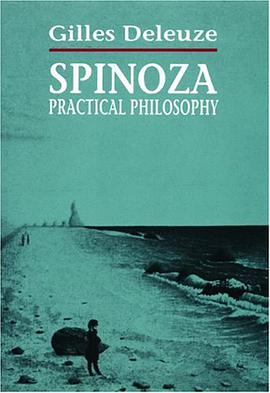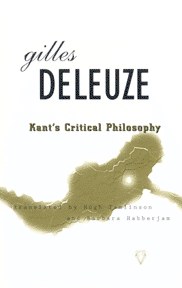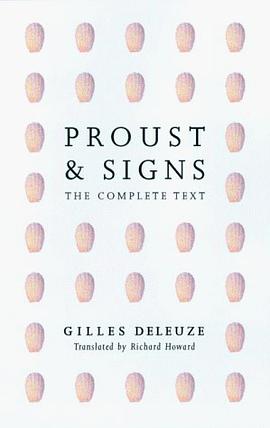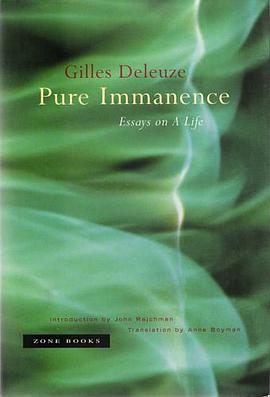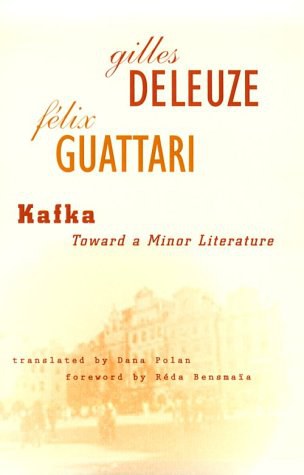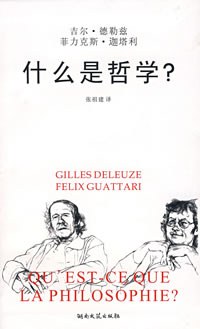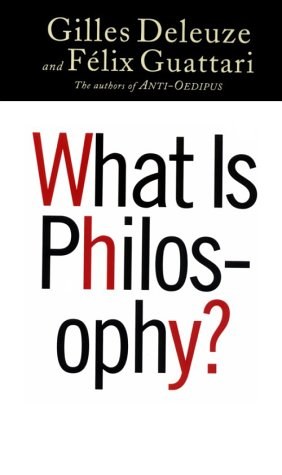Deleuze
康德的批判哲学 豆瓣
Kants kritische Philosophie
9.8 (8 个评分)
作者:
[法]吉尔·德勒兹
译者:
夏莹
/
牛子牛 译
…
西北大学出版社
2018
该书是德勒兹1963年出版的著作,原版在一百余页的篇幅中,将康德的三大批判体系解释为诸职能(faculté)的三种“法权的”关系构成的一架宏伟“机器”,并将代表着“自由的和谐”的第三批判奠立为代表着“有所立法的一致”的前两个批判奠基的“起源(genèse)”。在德勒兹哲学生涯的早期,即“哲学史”时期,这本小书紧随着其成名作《尼采与哲学》(1962)出版,它被德勒兹自己称作对康德的一次“敌情侦察”,但也包含着德勒兹对康德哲学的态度的转折。这一转折对理解德勒兹思想整体的发展都有着指示作用。进一步发挥其中对第三批判的解释的论文《康德美学中的起源理念》收录在《荒岛集》中。
Bergsonism 豆瓣
作者:
Gilles Deleuze
译者:
Hugh Tomlinson
/
Barbara Habberiam
Zone Books
1988
In this analysis of one major philosopher by another, Gilles Deleuze identifies three pivotal concepts - duration, memory, and élan vital - that are found throughout Bergson's writings and shows the relevance of Bergson's work to contemporary philosophical debates. He interprets and integrates these themes into a single philosophical program, arguing that Bergson's philosophical intentions are methodological. They are more than a polemic against the limitations of science and common sense, particularly in Bergson's elaboration of the explanatory powers of the notion of duration - thinking in terms of time rather than space.
《荒岛》及其他文本 豆瓣
L'îlle deserte et autres textes: textes et entretiens 1953-1974
8.9 (10 个评分)
作者:
[法] 吉尔·德勒兹 著
/
[法] 大卫·拉普雅德 编
译者:
董树宝
/
胡新宇
…
南京大学出版社
2018
- 1
这是吉尔·德勒兹的第一本文集,几乎辑录了他从1953年至1974年在国内外发表的全部文本,从他的第一部专著《经验主义与主体性》的出版,一直到他与菲利克斯·加塔利合著的 《反俄狄浦斯》问世后所引发的各种争论。主要包括德勒兹已经发表的文章、报告、序言、谈话、会议论文,这些文本从未收入德勒兹已经出版的任何一本著作之中。
A Thousand Plateaus 豆瓣 Goodreads
Mille Plateaux
作者:
Gilles Deleuze
/
Felix Guattari
译者:
Brian Massumi
University of Minnesota Press
1987
A Thousand Plateaus continues the work Gilles Deleuze and Félix Guattari began in Anti-Oedipus and has now become established as one of the classic studies of the development of critical theory in the late twentieth century. It occupies an important place at the center of the debate reassessing the works of Freud and Marx, advancing an approach that is neither Freudian nor Marxist but which learns from both to find an entirely new and radical path. It presents an attempt to pioneer a variety of social and psychological analyses free of the philosophical encumbrances criticized by postmodern writers. A Thousand Plateaus is an essential text for feminists, literary theorists, social scientists, philosophers, and others interested in the problems of contemporary Western culture.
Cinema 1 豆瓣
作者:
Gilles Deleuze
Univ Of Minnesota Press
1986
- 10
First published in France in 1983, this is at once a revolutionary work in philosophy and a book about cinema. For Deleuze, philosophy cannot be a reflection of something else; philosophical concepts are, rather, the images of thought, to be understood on their own terms. Here he puts this view of philosophy to work in understanding the concepts-or images-of film. Cinema, to Deleuze, is not a language that requires probing and interpretation, a search for hidden meanings; it can be understood directly, as a composition of images and signs, pre-verbal in nature. Thus he offers a powerful alternative to the psychoanalytic and semiological approaches that have dominated film studies.
Drawing upon Henri Bergson's thesis on perception and C. S. Peirce's classification of images and signs, Deleuze is able to put forth a new theory and taxonomy of the image, which he then applies to concrete examples from the work of a diverse group of filmmakers—Griffith, Eisenstein, Pasolini, Rohmer, Bresson, Dreyer, Stroheim, Buñuel, and many others. Because he finds movement to be the primary characteristic of cinema in the first half of the twentieth century, he devotes this first volume to that aspect of film. In the years since World War II, time has come to dominate film; that shift, and the signs and images associated with it, are addressed in Cinema 2: The Time-Image.
"The appearance of [this book] is an exciting event for film study and one that well deserves serious attention and commentary." —Film Quarterly
Drawing upon Henri Bergson's thesis on perception and C. S. Peirce's classification of images and signs, Deleuze is able to put forth a new theory and taxonomy of the image, which he then applies to concrete examples from the work of a diverse group of filmmakers—Griffith, Eisenstein, Pasolini, Rohmer, Bresson, Dreyer, Stroheim, Buñuel, and many others. Because he finds movement to be the primary characteristic of cinema in the first half of the twentieth century, he devotes this first volume to that aspect of film. In the years since World War II, time has come to dominate film; that shift, and the signs and images associated with it, are addressed in Cinema 2: The Time-Image.
"The appearance of [this book] is an exciting event for film study and one that well deserves serious attention and commentary." —Film Quarterly
Cinema 2 豆瓣
作者:
Gilles Deleuze
译者:
Hugh Tomlinson
/
Robert Galeta
Univ Of Minnesota Press
1989
- 8
Cinema 2: The Time-Image brings to completion Gilles Deleuze's work on the theoretical implications of the cinematographic image. In Cinema 1: The Movement-Image, Deleuze proposed a new way to understand narrative cinema, based on Henri Bergson's notion of the movement-image and C. S. Peirce's classification of images and signs. In Cinema 2, he explains why, since World War II, time has come to dominate film: the fragment or solitary image, in supplanting narrative cinema's rational development of events, illustrates this new significance of time.
Deleuze ascribes this shift to the condition of postwar Europe: the situations and spaces "we no longer know how to describe"—buildings deserted but inhabited, cities undergoing demolition or reconstruction—and the new race of characters who emerged from this rubble, mutants, who "saw rather than acted." Deleuze discusses the films of Rossellini, De Sica, Fellini, Godard, Resnais, Antonioni, Pasolini, Rohmer, Ophuls, and many others, suggesting that contemporary cinema, far from being dead, is only beginning to find new ways to capture time in the image.
Deleuze ascribes this shift to the condition of postwar Europe: the situations and spaces "we no longer know how to describe"—buildings deserted but inhabited, cities undergoing demolition or reconstruction—and the new race of characters who emerged from this rubble, mutants, who "saw rather than acted." Deleuze discusses the films of Rossellini, De Sica, Fellini, Godard, Resnais, Antonioni, Pasolini, Rohmer, Ophuls, and many others, suggesting that contemporary cinema, far from being dead, is only beginning to find new ways to capture time in the image.
Negotiations 1972-1990 豆瓣
作者:
Gilles Deleuze
译者:
Martin Joughin
Columbia University Press
1997
- 4
Negotiations traces the intellectual journey of a man widely acclaimed as one of the most important French philosphers. A provocative guide to Deleuze by Deleuze, the collection clarifies the key critical concepts in the work of this vital figure in contemporary philosphy, who has had a lasting impact on a variety of disciplines, including aesthetics, film theory, psycho-analysis, and cultural studies.
Nietzsche and Philosophy 豆瓣
Nietzsche et la philosophie
作者:
Gilles Deleuze
Columbia University Press
1983
- 4
-- Times Higher Education Supplement</P><br/>
Nietzsche and Philosophy has long been recognized as one of the most important accounts of Nietzsche's philosophy, acclaimed for its rare combination of scholarly rigour and imaginative interpretation. Yet this is more than a major work on Nietzsche: the book opened a whole new avenue in post-war thought. Here Deleuze shows how Nietzsche began a new way of thinking which breaks with the dialectic as a method and escapes the confines of philosophy itself.</P>
Nietzsche and Philosophy has long been recognized as one of the most important accounts of Nietzsche's philosophy, acclaimed for its rare combination of scholarly rigour and imaginative interpretation. Yet this is more than a major work on Nietzsche: the book opened a whole new avenue in post-war thought. Here Deleuze shows how Nietzsche began a new way of thinking which breaks with the dialectic as a method and escapes the confines of philosophy itself.</P>
Spinoza 豆瓣
作者:
Gilles Deleuze
译者:
Robert Hurley
City Lights Publishers
2001
- 1
Spinoza's theoretical philosophy is one of the most radical attempts to construct a pure ontology with a single infinite substance. This book, which presents Spinoza's main ideas in dictionary form, has as its subject the opposition between ethics and morality, and the link between ethical and ontological propositions. His ethics is an ethology, rather than a moral science. Attention has been drawn to Spinoza by deep ecologists such as Arne Naess, the Norwegian philosopher; and this reading of Spinoza by Deleuze lends itself to a radical ecological ethic. As Robert Hurley says in his introduction, "Deleuze opens us to the idea that the elements of the different individuals we compose may be nonhuman within us. One wonders, finally, whether Man might be defined as a territory, a set of boundaries, a limit on existence." Gilles Deleuze, known for his inquiries into desire, language, politics, and power, finds a kinship between Spinoza and Nietzsche. He writes, ""Spinoza did not believe in hope or even in courage; he believed only in joy and in vision . . . he more than any other gave me the feeling of a gust of air from behind each time I read him, of a witch's broom that he makes one mount. Gilles Deleuze was a professor of philosophy at the University of Paris at Vincennes. Robert Hurley is the translator of Michel Foucault's History of Sexuality.
Kant's Critical Philosophy 豆瓣
作者:
Gilles Deleuze
译者:
Hugh Tomlinson
/
Barbara Habberjam
Athlone Press
1984
Proust and Signs 豆瓣
作者:
Gilles Deleuze
译者:
Howard, Richard
Univ Of Minnesota Press
2004
The essential work on Proust--now in paperback In a remarkable instance of literary and philosophical interpretation, the incomparable Gilles Deleuze reads Marcel Proust's work as a narrative of an apprenticeship--more precisely, the apprenticeship of a man of letters. Considering the search to be one directed by an experience of signs, in which the protagonist learns to interpret and decode the kinds and types of symbols that surround him, Deleuze conducts us on a corollary search--one that leads to a new understanding of the signs that constitute A la recherche du temps perdu. In Richard Howard's graceful translation, augmented with an essay that Deleuze added to a later French edition, Proust and Signs is the complete English version of this work. Admired as an imaginative and innovative study of Proust and as one of Deleuze's more accessible works, Proust and Signs stands as the writer's most sustained attempt to understand and explain the work of art.
Pure Immanence 豆瓣
作者:
Gilles Deleuze
译者:
Boyman, Anne
Zone Books
2005
- 3
The essays in this book present a complex theme at the heart of the philosophy of Gilles Deleuze, what in his last writing he called simply "a life." They capture a problem that runs throughout his work--his long search for a new and superior empiricism. Announced in his first book, on David Hume, then taking off with his early studies of Nietzsche and Bergson, the problem of an "empiricist conversion" became central to Deleuze's work, in particular to his aesthetics and his conception of the art of cinema. In the new regime of communication and information-machines with which he thought we are confronted today, he came to believe that such a conversion, such an empiricism, such a new art and will-to-art, was what we need most. The last, seemingly minor question of "a life" is thus inseparable from Deleuze's striking image of philosophy not as a wisdom we already possess, but as a pure immanence of what is yet to come. Perhaps the full exploitation of that image, from one of the most original trajectories in contemporary philosophy, is also yet to come.
Kafka 豆瓣 Goodreads
作者:
Gilles Deleuze
/
Félix Guattari
译者:
Dana Polan
/
Réda Bensmaïa
University of Minnesota Press
1986
- 10
其它标题:
Kafka: Toward a Minor Literature
In Kafka Deleuze and Guattari free their subject from his (mis)interpreters. In contrast to traditional readings that see in Kafka's work a case of Oedipalized neurosis or a flight into transcendence, guilt, and subjectivity, Deleuze and Guattari make a case for Kafka as a man of joy, a promoter of radical politics who resisted at every turn submission to frozen hierarchies.
什么是哲学 豆瓣
9.5 (11 个评分)
作者:
吉尔·德勒兹
/
菲力克斯·迦塔利
译者:
张祖建
湖南文艺出版社
2007
- 7
德勒兹一生中与迦塔利合写过多部作品,《卡夫卡——为弱势文学而作》和《什么是哲学》是其中的两部。
在《卡夫卡》中,作者强调卡夫卡喜欢用一种称为“弱势”的文学术语,从语言、政治和群体上定义自己,同时又指出,弱势文学是大文学中彻底革命的元素。
在《什么是哲学?》中,作者指出:哲学作为创造概念的活动,应该告诉我们什么是概念的创造性本质,什么是随之相生的纯粹的内在性、内在平面和概念性的人物。正是通过这一点,哲学区别于科学和逻辑。
目 录
卡夫卡——为弱势文学而作
第一章 内容和表达
低垂的头和抬起的头——照片和音响
第二章 夸大的俄狄浦斯情结
双重超越:社会三角,动物之变
第三章 什么是弱势文学
语言行为——政治因素——群体因素
第四章 表达的构成成分
情书和邪恶盟约——短篇小说和动物之变——小说和机能性布局
第五章 内在性和欲望
反法律、负罪感和其他——过程、比邻,延续和无限度
第六章 层出不穷的系列
权力问题——欲望、片断和路线
第七章 联接手段
女人和艺术家——艺术的反美学倾向
第八章 单元,系列,强度
卡夫卡所说的两种营养造状态——单元的各种形式与小说的构造——矫揉造作
第九章 什么是配置?
话语和欲望,表达和内容
法汉译名对照表
什么是哲学
导论 问题因而就是
Ⅰ哲学
1.什么是概念?
2.内在性平面
3.概念性人物
4.地理哲学
Ⅱ哲学、科学逻辑和艺术
5.函项与概念
6.前景与概念
7.感知物、情态和概念
结论 从混沌到大脑
法汉译名对照表
译者谨识
在《卡夫卡》中,作者强调卡夫卡喜欢用一种称为“弱势”的文学术语,从语言、政治和群体上定义自己,同时又指出,弱势文学是大文学中彻底革命的元素。
在《什么是哲学?》中,作者指出:哲学作为创造概念的活动,应该告诉我们什么是概念的创造性本质,什么是随之相生的纯粹的内在性、内在平面和概念性的人物。正是通过这一点,哲学区别于科学和逻辑。
目 录
卡夫卡——为弱势文学而作
第一章 内容和表达
低垂的头和抬起的头——照片和音响
第二章 夸大的俄狄浦斯情结
双重超越:社会三角,动物之变
第三章 什么是弱势文学
语言行为——政治因素——群体因素
第四章 表达的构成成分
情书和邪恶盟约——短篇小说和动物之变——小说和机能性布局
第五章 内在性和欲望
反法律、负罪感和其他——过程、比邻,延续和无限度
第六章 层出不穷的系列
权力问题——欲望、片断和路线
第七章 联接手段
女人和艺术家——艺术的反美学倾向
第八章 单元,系列,强度
卡夫卡所说的两种营养造状态——单元的各种形式与小说的构造——矫揉造作
第九章 什么是配置?
话语和欲望,表达和内容
法汉译名对照表
什么是哲学
导论 问题因而就是
Ⅰ哲学
1.什么是概念?
2.内在性平面
3.概念性人物
4.地理哲学
Ⅱ哲学、科学逻辑和艺术
5.函项与概念
6.前景与概念
7.感知物、情态和概念
结论 从混沌到大脑
法汉译名对照表
译者谨识
What Is Philosophy? 豆瓣 Goodreads
作者:
Gilles Deleuze
/
Félix Guattari
Columbia University Press
1996
- 4
Called by many France's foremost philosopher, Gilles Deleuze is one of the leading thinkers in the Western World. His acclaimed works and celebrated collaborations with Félix Guattari have established him as a seminal figure in the fields of literary criticism and philosophy. The long-awaited publication of What is Philosophy? in English marks the culmination of Deleuze's career. Deleuze and Guattari differentiate between philosophy, science, and the arts, seeing as means of confronting chaos, and challenge the common view that philosophy is an extension of logic. The authors also discuss the similarities and distinctions between creative and philosophical writing. Fresh anecdotes from the history of philosophy illuminate the book, along with engaging discussions of composers, painters, writers, and architects. A milestone in Deleuze's collaboration with Guattari, What is Philosophy? brings a new perspective to Deleuze's studies of cinema, painting, and music, while setting a brilliant capstone upon his work.
